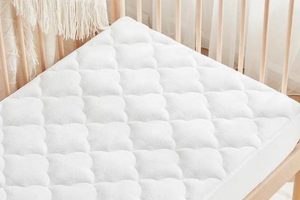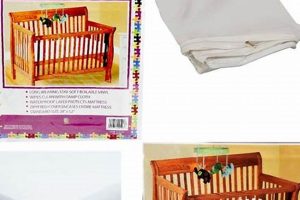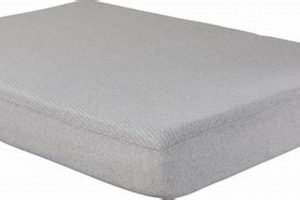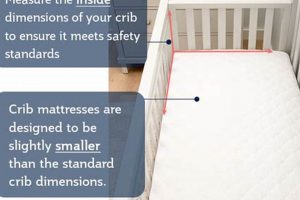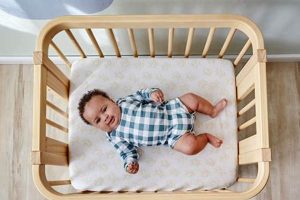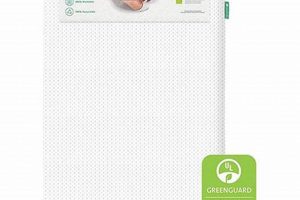A circular sleeping surface designed for infant use within a correspondingly shaped enclosure provides a distinct aesthetic and spatial alternative to traditional rectangular models. These products are typically constructed with materials adhering to safety standards for babies, incorporating features like firm support and breathable fabrics to promote safe sleep practices.
The appeal of this design lies in its space-saving potential, particularly in smaller nurseries, and its visually softer appearance. Historically, uniquely shaped cribs have been favored for their aesthetic qualities and perceived comfort. The primary benefit is often attributed to the crib’s non-traditional design, which can complement modern or minimalist dcor. Choosing a sleeping surface that meets safety regulations and promotes healthy sleep patterns for the infant remains of paramount importance.
Considerations such as size variations, material composition, safety certifications, and compatibility with available crib models are essential when selecting this type of bedding. The following sections will delve into these specific aspects, providing a detailed overview to inform purchasing decisions and usage best practices.
Essential Considerations for Round Crib Mattress Selection
Selecting bedding for an infant requires careful evaluation. Several factors influence the suitability of a circular crib mattress to ensure a safe and comfortable sleep environment.
Tip 1: Verify Dimensions for Compatibility: Accurately measure the interior diameter of the circular crib. A precise fit eliminates gaps that pose entrapment hazards. Refer to manufacturer specifications for compatible dimensions.
Tip 2: Prioritize Firmness for Infant Safety: A sufficiently firm surface is crucial to reduce the risk of Sudden Infant Death Syndrome (SIDS). Select a mattress that meets recommended firmness standards for infant bedding.
Tip 3: Evaluate Material Composition and Certifications: Investigate materials for potential allergens or toxins. Look for certifications such as GREENGUARD Gold, which indicates low chemical emissions.
Tip 4: Assess Cover Breathability and Waterproofing: A breathable cover enhances airflow, minimizing overheating. A waterproof layer protects the mattress core from moisture and spills, promoting hygiene.
Tip 5: Examine Seam Integrity and Construction Quality: Thoroughly inspect seams and edges for durability and resistance to separation. Robust construction ensures longevity and continued safety.
Tip 6: Consider Weight and Ease of Handling: A lighter mattress simplifies changing linens and cleaning the crib. However, prioritize safety and quality over minimizing weight.
Tip 7: Check for Secure Fit of Sheets: Ensure standard circular crib sheets fit snugly around the mattress. Loose bedding can present a suffocation hazard.
Adhering to these recommendations will contribute to a secure and comfortable sleep environment for the infant. A well-informed selection process minimizes potential risks associated with non-standard crib mattress designs.
The subsequent sections will discuss cleaning protocols and long-term maintenance strategies to preserve the integrity and lifespan of the circular crib mattress.
1. Diameter Compatibility
Diameter compatibility is a paramount consideration when selecting a circular crib mattress. Proper fit ensures infant safety by preventing gaps between the mattress and crib frame, which can pose a significant risk of entrapment.
- Measurement Accuracy
Precise measurement of the interior diameter of the circular crib frame is essential. Manufacturers typically specify compatible mattress diameters, and deviations from these specifications can lead to hazardous gaps. Accuracy in measurement is not merely a suggestion but a strict requirement for safe usage.
- Standard vs. Non-Standard Sizes
While some manufacturers adhere to common diameter standards, variations exist. It is crucial to verify that a chosen mattress corresponds exactly to the crib’s interior dimensions. A mattress advertised as a “standard” size may still differ slightly, necessitating meticulous comparison of specifications.
- Material Compression and Tolerance
Mattress materials may compress slightly over time. However, initial fit should be snug but not overly tight, allowing for minimal compression. Manufacturers often specify a tolerance range within which the mattress diameter should fall. Exceeding this tolerance in either direction compromises safety.
- Sheet Fit and Dimensional Stability
The diameter compatibility directly impacts the fit of crib sheets. If the mattress is undersized, sheets will be loose, creating a suffocation hazard. If oversized, sheets will be excessively stretched, potentially compromising their integrity. Proper diameter ensures sheets fit snugly, maintaining a secure sleeping surface.
The interplay between these facets underscores the critical role of diameter compatibility in ensuring the safety and functionality of circular crib mattresses. Neglecting these considerations introduces unacceptable risks. Parents and caregivers must meticulously verify dimensions to safeguard the infant’s well-being.
2. Firmness Standards
Firmness standards for infant mattresses are crucial for mitigating the risk of Sudden Infant Death Syndrome (SIDS). The design of the round crib mattress necessitates a specific focus on these standards to ensure the product provides a safe sleeping environment.
- SIDS Risk Mitigation
A firm surface reduces the risk of SIDS by preventing the infant from sinking into the mattress, which can lead to airway obstruction. Standards dictate a level of firmness sufficient to maintain an open airway, particularly when the infant is placed on their back, the recommended sleeping position. Circular mattresses must meet these same minimum firmness criteria.
- Testing and Certification Protocols
Established testing protocols, often involving weight distribution tests, evaluate mattress firmness. Certifications like those from ASTM International provide assurance that a mattress meets the specified standards. Manufacturers of round crib mattresses must subject their products to these evaluations to demonstrate compliance with safety requirements.
- Material Composition and Density
The materials used in the construction of a mattress contribute directly to its firmness. High-density foam or innerspring systems are commonly employed to achieve the required level of support. Producers of circular mattresses must carefully select materials that can maintain consistent firmness across the entire surface, accounting for the unique shape.
- Long-Term Firmness Retention
Mattress firmness should not degrade significantly over time. Standards often include guidelines for assessing firmness after simulated use, ensuring the mattress continues to provide adequate support. Manufacturers of circular models should demonstrate that their products retain their firmness under typical usage conditions, providing parents with assurance of continued safety.
The integration of firmness standards into the design and manufacturing of round crib mattresses represents a critical aspect of infant safety. Compliance with established protocols, careful material selection, and ongoing testing are essential to ensure these mattresses offer a secure and supportive sleep surface, mitigating the risk of SIDS.
3. Material Safety
Material safety is paramount in the context of infant bedding, specifically round crib mattresses. The direct and prolonged contact between the infant and the mattress necessitates stringent control over the composition of materials used in its construction. Substances deemed safe for general use may present unacceptable risks to infants due to their heightened vulnerability and tendency to mouth objects. The selection of materials directly impacts potential exposure to volatile organic compounds (VOCs), flame retardants, phthalates, and heavy metals, all of which pose potential health hazards. For example, substandard mattresses utilizing polyurethane foam without proper VOC emission testing may off-gas harmful chemicals, leading to respiratory irritation or other adverse effects. Conversely, models constructed with organic cotton, natural latex, or rigorously tested synthetic materials minimize these risks.
Certifications such as GREENGUARD Gold provide a reliable indicator of material safety, signifying that a mattress has undergone testing for thousands of chemicals and VOCs. These certifications establish acceptable emission limits, assuring parents that the product meets stringent standards for indoor air quality. Furthermore, the choice of cover material influences both breathability and the potential for allergen exposure. Hypoallergenic fabrics, such as bamboo or tightly woven cotton, reduce the accumulation of dust mites and other allergens that could trigger allergic reactions. In cases where waterproofing is desired, materials like food-grade polyethylene film offer a safer alternative to PVC, which may contain harmful phthalates.
The selection of a round crib mattress requires a comprehensive understanding of material safety and the implications of chemical exposure for infant health. Prioritizing mattresses constructed with certified safe materials minimizes potential risks and provides parents with greater confidence in the well-being of their child. Ongoing research and stricter regulatory oversight are essential to continually refine material safety standards and ensure that all infant bedding products adhere to the highest levels of safety.
4. Breathable Cover
The integration of a breathable cover into a round crib mattress design serves as a critical component in mitigating the risk of infant overheating and promoting optimal thermal regulation. A non-breathable cover restricts airflow, leading to elevated temperatures and increased humidity within the sleeping environment. This creates a potential for discomfort and, in extreme cases, contributes to the risk of hyperthermia, a factor linked to Sudden Infant Death Syndrome (SIDS). Breathable materials, such as open-weave cotton or specialized synthetic fabrics, facilitate the evaporation of moisture and dissipation of heat, maintaining a more stable and comfortable temperature for the infant. For instance, a mattress cover constructed from 3D spacer fabric allows for continuous air circulation, even when compressed by the infant’s weight, preventing heat buildup.
The effectiveness of a breathable cover is directly influenced by its material composition and construction. Tightly woven fabrics, while offering durability, may compromise breathability compared to looser weaves or materials with inherent air permeability. The use of natural fibers, such as organic cotton or bamboo, further enhances breathability due to their inherent moisture-wicking properties. Furthermore, design features like ventilation holes or mesh panels integrated into the cover can augment airflow, creating a more effectively ventilated sleeping surface. In practice, a breathable cover allows for improved air exchange around the infant’s head and body, reducing the likelihood of overheating and promoting a more restful sleep.
In summary, the inclusion of a breathable cover in the design of a round crib mattress represents a crucial safety feature. It directly addresses the risk of infant overheating, contributing to a more comfortable and secure sleeping environment. Choosing a round crib mattress with a certified breathable cover, constructed from appropriate materials and designed to maximize airflow, offers a proactive approach to promoting infant well-being. Challenges remain in establishing universal standards for breathability testing and in educating caregivers about the importance of this feature. Continued research and informed consumer choices are essential to ensure that round crib mattresses prioritize infant safety and comfort.
5. Secure Sheet Fit
Secure sheet fit is a critical safety element in the context of round crib mattresses. Deviations from a proper fit introduce hazards, compromising the integrity of the sleep environment designed for infant well-being. The unique shape of the circular mattress necessitates specific attention to sheet dimensions and fastening mechanisms.
- Elasticity and Tension Distribution
Elasticity within the sheet material dictates its ability to conform to the mattress shape while maintaining consistent tension. Inadequate elasticity results in bunching or looseness, creating potential entanglement risks. Uniform tension distribution prevents localized stress points that could lead to tearing or detachment. A sheet designed with sufficient elasticity, such as those incorporating spandex or similar fibers, and reinforced seams better ensures proper contact with the mattress surface.
- Circumferential Measurement Accuracy
The circumference of the fitted sheet must precisely match that of the round crib mattress. Inaccurate measurements, stemming from manufacturing inconsistencies or improper labeling, result in either an excessively tight or loose fit. A sheet that is too tight places undue stress on the elastic and seams, potentially leading to premature failure. A loose sheet creates folds and wrinkles that pose suffocation risks. Precise circumferential measurement and adherence to established sizing standards are vital.
- Fastening Mechanisms and Retention
The means by which the sheet attaches to the mattress contributes significantly to its secure fit. While elastic edges are standard, their strength and durability vary. Reinforced elastic casings and robust stitching are necessary to withstand repeated washing and stretching. Additional fastening mechanisms, such as snaps or hook-and-loop closures, provide enhanced retention, preventing the sheet from dislodging during infant movement. Secure fastening minimizes the risk of entrapment between the sheet and mattress.
- Material Composition and Surface Friction
The material composition of the sheet influences its surface friction against both the mattress and the infant. Slippery materials, such as some synthetic blends, increase the likelihood of sheet slippage, particularly on smooth mattress surfaces. Materials with a higher coefficient of friction, such as tightly woven cotton, provide better grip, reducing the potential for displacement. A sheet’s texture and fiber content are therefore significant factors in maintaining secure contact.
These interconnected aspects underscore the importance of a secure sheet fit for round crib mattresses. Addressing each element, from elasticity to material composition, mitigates potential hazards and ensures a safe sleeping environment for the infant. Continuous monitoring and adherence to established safety guidelines are essential to maintaining the integrity of the sheet-mattress interface.
Frequently Asked Questions About Round Crib Mattresses
The following questions address common concerns and provide essential information regarding round crib mattresses. These answers are intended to offer clarity and guidance for informed decision-making.
Question 1: What are the specific benefits of a circular crib mattress compared to a traditional rectangular one?
Circular crib mattresses often provide a more compact footprint, potentially optimizing space in smaller nurseries. Their design can also offer a softer aesthetic, complementing specific room decors. However, functional benefits related to infant sleep quality are generally equivalent to those of rectangular mattresses provided both meet established safety and firmness standards.
Question 2: Are there specific safety standards that apply exclusively to circular crib mattresses?
No safety standards apply exclusively to circular crib mattresses. All crib mattresses, regardless of shape, must adhere to general safety standards concerning firmness, material composition, and absence of hazardous substances. Verification of compliance with ASTM standards and certifications like GREENGUARD Gold remains essential.
Question 3: How does one ensure the proper fit of a sheet for a round crib mattress?
Precise measurement of the mattress circumference is critical. Fitted sheets designed specifically for the stated diameter of the mattress must be used. The sheet should fit snugly, without looseness or excessive stretching, indicating a proper and safe fit.
Question 4: What type of material is best suited for a circular crib mattress, considering both safety and comfort?
Materials prioritizing safety and comfort include high-density foam meeting flammability standards, organic cotton covers for breathability, and hypoallergenic materials to reduce allergen exposure. Certifications like Oeko-Tex provide assurance of material safety and reduced chemical emissions.
Question 5: How should a circular crib mattress be cleaned and maintained to prolong its lifespan?
Spot cleaning with a mild detergent and water is recommended for surface stains. Avoid immersing the mattress in water or using harsh chemicals. Regularly rotate the mattress to promote even wear. Using a waterproof mattress protector safeguards against spills and stains, extending the mattress’s usability.
Question 6: Where can replacement sheets specifically designed for circular crib mattresses be sourced?
Replacement sheets are often available from the crib manufacturer or specialty bedding retailers. Online marketplaces also offer a variety of options. Ensure that the sheet dimensions precisely match the mattress diameter to guarantee a secure fit.
These answers provide a foundational understanding of essential aspects related to circular crib mattresses. Prioritizing safety, proper fit, and appropriate materials ensures a secure and comfortable sleeping environment for the infant.
The subsequent section will address cleaning protocols and long-term maintenance strategies to preserve the integrity and lifespan of the circular crib mattress.
Round Crib Mattress
This exploration of the round crib mattress has illuminated several critical considerations, from diameter compatibility and firmness standards to material safety, breathable covers, and secure sheet fit. These factors collectively determine the suitability of this specialized bedding for infant use. The absence of compromise in any of these areas is paramount to mitigating potential risks associated with infant sleep environments.
Responsible purchasing and diligent maintenance are incumbent upon caregivers seeking to provide a safe and comfortable sleep space. Prioritizing certified products, verifying dimensions, and adhering to recommended cleaning protocols are essential steps. The ongoing commitment to informed decision-making remains the cornerstone of infant safety and well-being when utilizing a round crib mattress.


